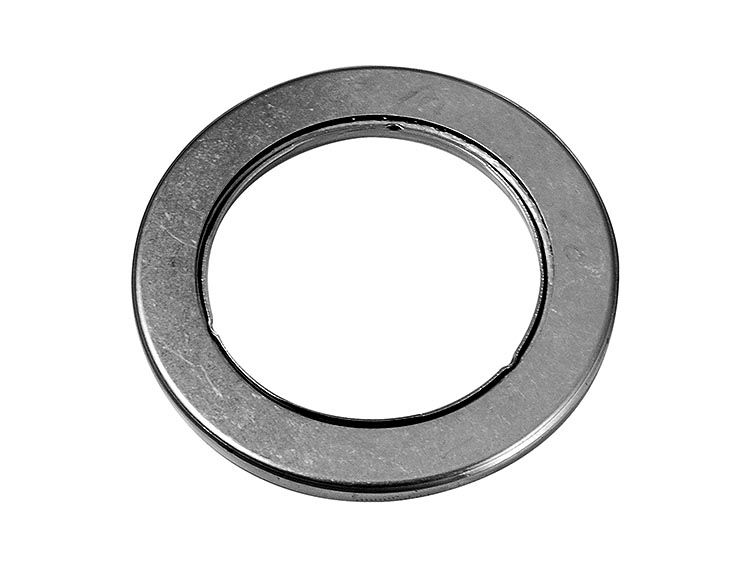Replace Those Honda Stator Bearings with Something More Readily Available
Ed Lee
Many late-model Honda converters have unique stator bearings. The caged roller part of the bearing is like the bearing used in the Jatco RE4R01A converters. This part of the bearing is not unique. The outboard races of the stator bearings also are not unique. The impeller side bearing runs against the flanged impeller hub, and the turbine side bearing runs against the turbine hub. It is the bearing races on either side of the stator that are unique (see Figure 1).
 |  |
The .080” thick races have four tabs that keep them from rotating and four slots for oil flow. The inside diameter also has a .035” lip to keep the caged roller part of the bearing centered. The impeller side and turbine side bearing race look the same, but perform different functions. The race on the impeller side does the traditional job of carrying thrust loads during acceleration. The race on the turbine side, on the other hand, has to do double duty. One duty of the turbine bearing race is to carry thrust loads during deceleration. The second duty is to retain the one-way clutch in the stator assembly. The 4-tab race sits on top of the aluminum stator cap and is held in place by a retaining ring (see Figure 2).
The caged roller section of the bearings is available through the aftermarket, but to date, the 4- tab race is not, either through the original equipment manufacturer or the aftermarket. To make things worse, some of the older Honda converters that continue to be manufactured today have been upgraded to this new type of bearing. The Dacco HO-12 and HO-16 are good examples of this. The converters with the upgraded bearing are identifiable on the outside because the impellers flare out more where they meet the ring gear (see Figure 3), and the converters with the early-style bearing flare out less (see Figure 4).
 |  |
On the inside, the converters with the upgraded stators and bearings will only have three stands on the turbine where the turbine mates to the damper assembly. Roger Weaver of Landis Converters in Leola, Pa., has found a way around the lack of replacement bearings. He uses a bearing from the overdrive section of one of the rear-wheel-drive Chrysler overdrive transmissions, such as the A500 or A518. The bearing is located on the overrunning clutch hub and separates the clutch hub from the output shaft. These bearings are available through the OEM (part number 1-04461014) as well as through the aftermarket (Sonnax part number MI-N-28). The replacement bearing is about .008” to .009” thinner than the OEM bearing, but this does not appear to affect performance.
Roger machines the I.D. of the bearing cavity in the stator to fit the O.D. of the replacement bearing. You are only machining about .025” of material from each side of the bore. Make sure that the relief that is cast into the bottom of the bore remains open for oil flow. Roger currently replaces all of the impeller side bearings, and has a surplus of good races, for the replacement of the turbine side if needed. Remember that the turbine side bearing race is also the retaining plate for the one-way stator clutch and cannot be replaced like the impeller side described above.
Special thanks to Roger Weaver for sharing his unique idea.
Ed Lee is a Sonnax Technical Specialist who writes on issues of interest to torque converter rebuilders. Sonnax supports the Torque Converter Rebuilders Association.
Related Units
Related Parts
Required
Recommended
HP Miscellaneous
Thrust Bearing MI-N-28
- Bearing Style: Enclosed
- Material: Hardened Steel
- Inner Dia.: 2.182"
- Thickness: 0.188"
- Outer Dia.: 3.226"
While Sonnax makes every effort to ensure the accuracy of technical articles at time of publication, we assume no liability for inaccuracies or for information which may become outdated or obsolete over time.
